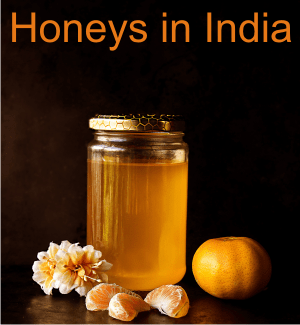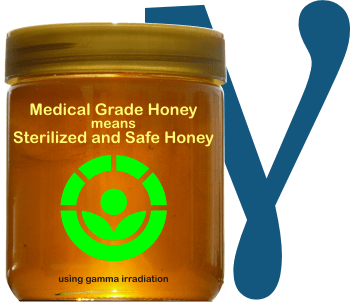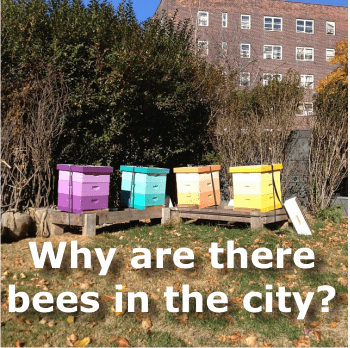And it was the 45th Apimondia International Apicultural. Which it was also the 120th Anniversary of Apimondia Congresses. The most important congress for all beekeepers and honey producers.
People say it was the best Apimondia Congress ever!
It was held in Istanbul, Turkey, and in those 5 days the BEE, the most amazing creature we all love, was literary worshiped. There were 13,000 participants from 128 countries. 350 exhibitors. Some with impressive facilities and equipment, with innovative hives and digital techniques, with diverse solutions in beekeeping, presenting a wide variety of bee products of various floral source, either raw or processed, originating in all continents.
There were beautiful shows with music and dance, organized trips and excellent accommodations.
Over 260 oral scientific communications and nearly 770 posters were presented. The following fields were intensely discussed:
· Bee Biology
· Beekeeping Technology and Quality
· Bee Health
· Beekeeping for Rural Development
· Pollination and Bee Flora
· Beekeeping Economy
· Apitherapy
All the problems of beekeeping and beekeepers were discussed and people looked for solutions together. After all countries are confronted with the same unfortunate CCD (Colony Collapse Disorder). See What causes CCD? Do pesticides kill bees? Or radiations? Pathogens? Aliens? and Neonicotinoids are poison to bees and our honey!
The World Beekeeping Awards Contest 2017
As always with every Apimondia Congress, a contest is also held to praise the best honey! There were 170 countries registered in the contest and the Turkish organizers received nearly 400 hundred honey samples from all around the world. There were 2 main categories, individual and commercial.
Individual Classes
Classes for individuals were designed especially for those for whom beekeeping was a fascinating, occasionally profitable hobby, or an exciting small business.
The World Beekeeping Awards 2017 for individuals covered all main classes of bee products such as: Extracted Honey produced by Apis mellifera, Honeydew Honey, Monofloral Honey, Polyfloral Honey, Granulated honey, Comb Honey, Honey products (with added cinnamon, nuts, dried fruits, etc.), Mead, Beeswax and Display (The Display classes was judged not only on the product quality aspects but also aesthetically).
And the winner is…..
· The first place at Extracted Honey produced by Apis mellifera class was HILAL MOHAMMED AL-WAILI, from Oman
· The best monofloral honey was won by MOHAMMED ALSARDY ALSHAMARY from Saudi Arabia
· The best polyfloral honey was won by SERGEI MULIUKOV from Russia
· The first place for granulated honey was awarded to JIM SAVOY from the USA
· The first place for comb honey was awarded to DİLEK ÖZKAN from Turkey
· The first place for Honey products (with added cinnamon, nuts, dried fruits, etc.) was awarded to MAREK VARGAPAL from Slovakia
· The best mead 🙂 was won by MAREK VARGAPAL from Slovakia.
Commercial Classes
Classes for commercial firms were specially created and designed for the bee product producers, traders, packers and other apicultural sector representatives from all over the world, for whom beekeeping is the principal business. Cosmetics was added to the above mentioned individual classes.
Why in Turkey, Istanbul?
It was a very well deserved honor for Turkey to be the host of this famous congress. Turkey is on the second place in apiculture in the world, with 150.000 families engaged in beekeeping and 6.8 million honey bee colonies. In the entire world there are over 83 million honey bee colonies. (China is the world’s leader in beekeeping; having the highest number of honey bee colonies, the largest producer of honey, royal jelly and other bee products. )
 picture source www.apimondia2017.org
picture source www.apimondia2017.org
Turkey is like the heaven of flowers. It contains three different phyto-geographic zones (European-Siberian, Mediterranean, and Iranian-Turanian), and serves as a bridge between Europe and Asia. There are 10.000 native plant species, nearly 3.900 of which are endemic. Almost 500 plants are known to provide nectar or pollen, and nearly 50 of them are identified as dominant nectar plants. Chestnut honey, thyme honey, mountain meadow honey, citrus honey, rhododendron honey and mixed flower honey are some of the most famous honey types in Turkey. Turkey holds the single largest share of the world’s pine honey production.
The Turkish Association of Beekeepers (TAB) includes 80 provincial unions, one serving each province and in total TAB has 58,000 members in Turkey. All beekeepers in Turkey are registered with the ARS (Apiculture Recording System), a joint program between TAB and the Turkish Ministry of Agriculture, and can be observed via a monitoring system.
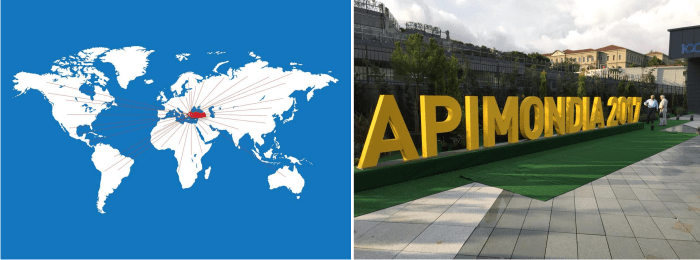 picture source www.apimondia2017.org
picture source www.apimondia2017.org
And have I mentioned that the most expensive honey in the world comes from Turkey? See here:The most expensive honey in the world is sold for 5000 euro per kilogram. Scam or not?
And I know some people who took the advantage of their staying in Turkey to also look for their famous hallucinogenic honey. Or for their honey known to help with the liver, Anzer honey.
The 45th Apimondia Congress was a challenge for Turkey and ended up as a complete success. In the scientific section there were over 260 oral scientific works and over 770 posters representing synthesis of other scientific papers. Apitherapy represented more than 1/5 of all presentations. Here are some of them:
Studies presented in the apitherapy section
• Synergistic Antibacterial Interaction between Yemini Sidr and Manuka Honey against Some Human Pathogens, by Mohammad Javed Ansari et al. from the Kingdom of Saudi Arabia, was presented with great success.
This project aimed to examine the antimicrobial properties of yemini sidr and Manuka honey against various Gram-positive and Gram-negative bacterial strain including MRSA.
The 2 honeys showed synergistic effect. The study demonstrated that bacterial pathogens and MRSA biofilm are susceptible to sub inhibitory concentrations of sidr and Manuka honey alone and in combination.
Conclusion: Combination of the sidr honey and manuka honey could lead to the development of new broad-spectrum antimicrobials that have the potential to prevent the emergence of resistant bacterial strains and could be a valuable antimicrobial agent for management of infections caused by these organisms.
also see: Sidr honey benefits for health
• Impact of Acacia Honey on Biofilm Inhibition in Bacteria with the Help of Atomic Force Microscopy, by Syed Ishtiaq Anjum et al., from Pakistan, ascertained the efficacy of Acacia honey for the prevention of biofilm formation in bacteria.
The tested dilutions of Acacia honey (9% and 13 % (w/v)) induced significant inhibitory effects on the formation of Bacillus strain ADQ biofilm. Exposure of Bacillus strain ADQ biofilms to 9 % and 13 % (w/v) Acacia honey in LB (Luria Broth) agar media resulted in significant morphological changes in bacterial cells.
Conclusion: Acacia honey is a potent inhibitor of biofilm formation in bacteria.
• Potential Protective Effects of Bioactive Constituents from Chinese Propolis against Acute Oxidative Stress Induced by Hydrogen Peroxide in Cardiac H9c2 Cells, by Liping Sun, China, investigated the effects of Chinese propolis and its active compounds on hydrogen peroxide (H2O2) induced rats cardiomyocytes (H9c2) oxidative injury.
Conclusion: The cardiovascular protective effects of the Chinese propolis, which might be attributed to its caffeates constituents (CAPE, BZC and CNC) provide evidence for its usage in complementary and alternative medicine.
• The mixture of Honey, Royal Jelly and Coenzyme Q10 Improves the Indicators of Heart Rate Variability in Elite Athletes, by Vasilii Krylov, Russia, showed that the achievement of a positive adaptation effect in athletes after administration royal jelly and coenzyme Q10 is indicative of an ergogenic effect of this combination of substances.
• Royal Jelly and Coenzyme Q10 Affect the Saliva Prooxidant/antioxidant Balance in Highly Qualified Athletes, by Vasilii Krylov, Russia, investigated free radical production and antioxidant buffering in highly qualified athletes` saliva after taking royal jelly and coenzyme Q10 suspended in bee honey in precompetitive period. And proved that taking the mixture of royal jelly and coenzyme Q10 reduces potential capacity to free-radical oxidation.
• Antibacterial Activity of Propolis Nano-particle and Propolis Against Gram Negative-Bacteria Escherichia Coli, bu Houshang Afrouzan, Iran, showed that the antibacterial activity of propolis Nano-particle against Escherichia coli was significantly better than the propolis (p<0.05). Results indicated that nanostructure of propolis is important for improving its antibacterial activity.
• Stress Reaction of Organism to the Action of Bee Venom, by Anna Deryugina st al., Russia, studied what stressing reaction features occur under effect of bee venom. The study proved that antichloristic and antirheumatic effects of apitoxin can be described as stressing reaction evolution caused by apitoxin effect, which cause
rather long phase of organism resistance. This phase is compensatory and connected with increasing of circulating glucocorticoids level. The hormones increase is aimed at eliminating the pathogenic stress factor.
• Immune Potential Activity of Honey, by Ahmed Hegazi et al., Egipt, concluded that honey acts upon both innate and adaptive immune response. At different levels, in the human innate response, these compounds decrease proinflammatory cytokine synthesis (IL-2, IL-12 and IL-4), inactivate both the classical and alternative complement pathway, and decrease superoxide anion production in neutrophils.
In adaptive immune response, honey induce the increase of antibody production by plasma cells, enhance the secretion of TGF-β after the activation of T regulatory cells.
also see: Seabuckthorn and honey or how to boost immune system naturally!
• Potential Mechanistic Basis for Honeybee Propolis Used in Modern Medicine: Caffeic Acid Phenethyl Ester Suppresses Stress Induced Damage via Modulation of Some Signalling Pathways, by Xing An Li et al., China, reviewed that “CAPE suppresses stress induced damage via modulation of some signalling pathways, including G-protein coupled receptor protein signaling cascade, receptor tyrosine protein kinase signal transduction pathway, and adenosine monophosphate-activated protein kinase molecular switch.”
• Propolis as a Candidate of Anticancer Drugs with “In-Silico” Approach from its Flavonoid Content, was presented by Akhmad Endang Zainal Hasan from Indonesia. He stressed on the fact that propolis can be used as a cure for cancer especially in its flavonoid content. Among them are apigenin, galangin, chrysin, quercetin, pinobanksin, pinocembrin, and tektochrysin.
also read: Propolis can prevent and treat LEUKEMIA and CANCER
• Apitoxines in the Treatment of Multiple Sclerosis, by Igor Vladimirovich Krivopalov Moskvin et al., Russia, presented a viable alternative to conventional drugs that cost much, should be used continuously and have no strong influence on destroyed myelin. the study showed how apitoxines increase the activity of autoimmune inflammation, activating hypothalamus-hypophysial-epinephrosis system and throwing out endogenous corticosteroids into blood stream.
also read: Bee venom for therapy: Multiple Sclerosis
• Effects of Flavonoids Rich Propolis Ethanolic Extract from Three Different Malaysian Stingless Bee, Trigona apicalis, Trigona itama and Trigona thoracica, on the Expression of Adhesion Molecules in Stimulated HUVEC EA.hy926, conducted by Nornaimah Asem et al. from Malaysia, reviewed the role of stingless bee propolis extracts in the modulation of the surface membrane expression and its antioxidant activities that lead to its medicinal properties.
• Effects of Bee Pollen on Methotrexate-Induced Testicular Damage in Rats, by Özlem Saral1, Arvin, Turkey, proved that bee pollen has a protective effect against MTX-induced testicular tissue damage.
• Bioactive constituent of Chinese Propolis,Pinocembrin,Triggers a Mitochondrial-independent Apoptosis via Caspase cascade Pathway in B16F10 Melanoma Cells, by Yufei Zheng et al, China, proved that Chinese propolis(CP),one flavonoid rich hive products, has potent anti-proliferative effects in mice B16F10 melanoma cells. The conclusion of the study was that pinocembrin preserves anti-melanoma activity and is capable of triggering cell death via mitochondrial-independent pathway.
• In-vitro Antibacterial Effect of Three Propolis Samples from Turkey on Some Biofilm Forming Bacteria, by Duygu Şimşek et al from Turkey, evaluated the effectiveness of three propolis sample from different regions of Turkey on some biofilm forming human pathogens. Microorganisms used in the experiment were Staphylococcus aureus ATCC 29213, Staphylococcus epidermidis ATCC 35984, Escherichia coli ATCC 35218, Enterococcus faecalis ATCC 29212, Klebsiella pneumoniae RSKK 574, Pseudomonas aeruginosa ATCC 27853. Test results indicates that all samples were showed significant antibacterial activity. It was observed that the effect on the Gram (+) bacteria was more prominent than on Gram (-) ones.
Results of this study shows that ethanol extracts of propolis may be used as antimicrobial agent in combination with antibiotics and synergistic effect studies will be carried out with taking these results into account.
• Integrated Apitherapy in Multiple Sclerosis – Clinical Study for 80 Patients in One Year of Treatment by Cristina Aoşan, Romania. The study took place from 2003 till 2017 and it was a complex one, including apitherapy (with bee venom or apitoxin, royal jelly, apilarnil, propolis, pollen, honey) along with phytotherapy, diet, psychotherapy, life style corrections, elements of Ayurveda and/or traditional Chinese medicine, applied respecting the needs of each patient.
After one year of treatment, the results were very promising: For the patients with the age under 40 years and for those near the debut (less than two years), the symptoms were recovered more than 80%
of the initial intensity to about 60 % of patients. Only about 6 % had a small improvement of the symptoms, under 20 % of the initial intensity.
On MRI an important part of the patients had improvements of the imagines, meaning that some disappeared or diminished. Others were stationary. The results showed that the patients near the debut, the young and those with positive psychic have the best chances to be completely recovered and to have a normal life. The MRI images showed good improvements.
• The Usage of Bee Hive – and Bee Hive Air- therapy for Treatment of Asthmatic Reactions of Beekeeper’s Children
Having Bee Venom Allergy, by János Körmendy Rácz et al. from Hungary, compared a clinical case (a 9yo boy with bee venom allergy) with the already known international results.
The bee hive therapy means includes several elements: the air, the warmness, the micro vibration, the negative iones and the sound of the hives. All these led to healing processes and helped with desensitization.
What cures asthma? Here is a solution from apitherapy: aerosols from the hive!
• Treatment of Upper Tract Respiratory Infections by 3% Ethanol Extracts of Propolis, by Veli Cicimen1 et al. from Turkey, presented a clinical study, which showed the effects of 3% Ethanol Extract of Propolis (EEP) (Gripoli), produced by Arı Farma Ltd., were tested on 19 patients having Upper Respiratory Tract Infections (URTI) by applying 3 x 1 spray a day for ten days to the mouth and throat.
From them, 18 patients showed complete recovery and only one did not report a disease progress. Out of 19 patients; symptoms of URTI, acute tonsillitis, acute rhino pharyngitis, pharyngitis, nasopharyngitis, allergic rhinitis completely disappeared on 6, 6, 2, 2, 2, 1 patients respectively.
Two patients having acute tonsillitis and one having nasopharyngitis had also Candida stomatitis and all the three patients also showed recovery of Candida stomatitis. No negative effects and complaints were observed on the patients.
Also see: Propolis treats otorhinolaryngologic and respiratory diseases
And the list of studies goes on. All showing intense and dedicated work into discovering everything about the effects of all bee products on human health. We respect and salute them all!
And in 2019 in Canada, let’s hope to attend another congress at least as amazing as this one.
Thank you Turkey for your contribution to the improvement of our alternative medicine and for supporting honey bees and humans as well!
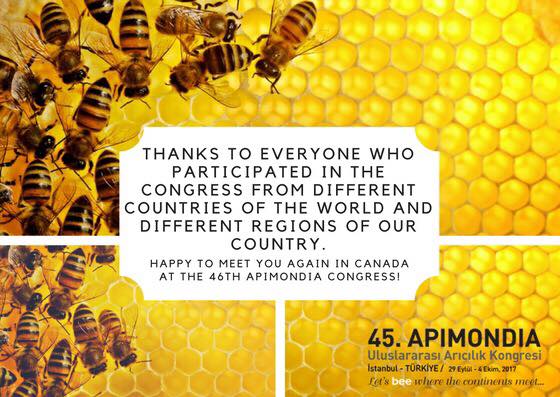
for other details feel free to access:
www.apimondia2017.org;
www.facebook.com/apimondia2017istanbul;
www.twitter.com/Apimondia2017
==============
==============
References and pictures’ source:
apimondia2017.org
melidava.ro

